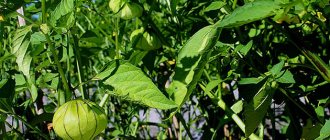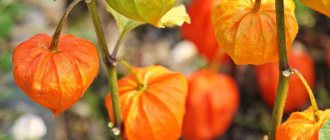Author: Elena N. https://floristics.info/ru/index.php?option=com_contact&view=contact&id=19 Category: Garden plants Published: February 24, 2019Last edits: November 03, 2020
- When to plant
- Growing conditions
- How and when to collect seeds
- Physalis floridana
- Beneficial features
plant (lat. Physalis) belongs to the largest genus of the Solanaceae family, which includes about 120 species growing in Asia, Europe, as well as in South and North America. Translated from Greek, physalis means bubble - the name is given because of the shape of the growing red-orange calyx of the plant. Gardeners sometimes call physalis earth cranberry or emerald berry, as well as bladderwrack, dog cherry and maroonka. Physalis is often compared to tomatoes - plants from the same family, and although these plants are similar in many ways, planting and caring for physalis in open ground has its differences.
Physalis vegetable: description
Growing vegetable physalis at home as a vegetable is not yet as popular as planting it for decorative purposes. Therefore, you should figure out how to grow physalis in your dacha, properly care for it and harvest on time.
Edible Physalis began to be grown at home in Russia in the 19th century. This practice came from European countries, where the plant came from its natural habitat - Central and South America.
Physalis vegetable
Physalis, depending on the variety, can reach a height of 1 meter. This is a perennial plant belonging to the nightshade family. Its closest cousins are potatoes and tomatoes.
On one bush, about 200 fruits can ripen in a season, which first grow in an orange or red cup-case similar to a lantern or a closed bell.
Note! It is this cover that protects the fetus from all adverse environmental influences, diseases and pests.
The large fruits of the plant weigh about 50 grams; there are vegetable varieties whose fruits weigh up to 80 grams. Unlike tomatoes, physalis fruits have a different color palette. Ripe fruits can be green, yellow, orange, red and purple.
What does physalis taste like?
It is impossible to immediately say what vegetable the taste of physalis is similar to, because the varieties are different. Some fruits taste like several berries and fruits: strawberries, grapefruit and a little grapes. Some species have a pineapple flavor.
Several vegetable species more closely resemble an unripe tomato; some varieties resemble gooseberries. Sometimes the taste is hot or bitter, but when preparing physalis preparations for the winter, all bitterness and sourness disappear.
The color of the fruit varies
Features of cultivation
Physalis does not require complicated care, but in order to get a good harvest, you still need to know a few rules:
- Although this unpretentious crop grows well in open ground, in the middle zone it is recommended to grow physalis in a greenhouse. This will extend fruiting: the harvest can be harvested not only in August, but until September-October;
- Physalis is grown mainly using the seedling method. It is recommended to sow seeds for seedlings in late March - mid-April, and plant them in a permanent place in late May - early June. The recommended planting density is 50 cm.
Experienced gardeners note that for low varieties, denser planting - 30–40 cm - will not only not harm the plants, but will also contribute to the quality and quantity of the harvest. Due to the dense interweaving of branches, a special microclimate is formed, which gives this effect;
- for cultivation you need to choose open areas - physalis loves the sun;
- The ideal temperature for growth is 18–25°C. Ornamental and some varieties of vegetable physalis can withstand light frosts. They can reproduce by self-seeding and, in some cases, produce a crop that has time to ripen. Strawberry physalis is more thermophilic. The only way to grow it for harvest is through seedlings;
- All soils are suitable for planting, except acidic ones. Excessively moist soils will also not contribute to a good harvest. Excessive application of manure is also undesirable. Good predecessors for physalis will be cabbage, pumpkin, carrots, and legumes. But after other nightshades - potatoes, tomatoes, eggplants - you shouldn’t plant it;
- Physalis bears fruit like pepper - the fruits are located in the forks of the branches, therefore, in order not to reduce the yield, the plant does not need to be pinched.
For physalis you need to choose a well-lit place
Physalis propagation
Due to their demanding climatic conditions, vegetable and strawberry physalis are grown in Russia as annual crops, so the seedling method of cultivation is the most acceptable. Physalis Franchet is less whimsical; it is capable of propagation by cuttings, lateral shoots, and even self-sowing.
Cuttings are carried out in July: the tops of the shoots with the most developed internodes are cut off and planted in loose soil, watered abundantly and covered with film, glass or cut plastic bottles with holes for ventilation. Before rooting, the cuttings should be in a shaded place, the soil under them should not dry out. When the leaves on the cuttings “come to life”, the plant is opened. The lateral shoots are separated from the bush and transplanted to the desired location.
To prevent decorative physalis from growing excessively, it can be planted in a barrel or other container dug into the ground. This will not only stop unwanted root spread, but will also create a bright, compact flower bed.
Physalis seedlings: from sowing to planting in the ground
Seeds for seedlings are usually sown in March-April (depending on the type and variety). You can use a special soil mixture for nightshade crops, but ordinary soil will be sufficient, as long as it is loose and fertile.
- Physalis is sown to a depth of 1.5–2 cm.
When sowing, physalis seeds are buried 1.5–2 cm
- The soil around the seed should be compacted a little and slightly moistened, the seeds should be covered with film and placed in a warm, bright place, shaded from direct sunlight.
- Seeds are grown at a temperature of 19–20°C.
- After the shoots appear, the physalis is opened, kept for 2–3 days at a temperature of 16–17°C, then placed again in a warm place.
After the emergence of physalis shoots, remove the cover from the container
Many gardeners germinate seeds before sowing. This procedure will help to reject ungerminated seeds, and germinated seeds will grow faster after sowing. You can germinate in a closed container on several layers of filter paper moistened with a very weak solution of manganese.
Dive
When the seedlings have four leaves, they are ready for picking.
- You can dive into a large box, maintaining a distance of 10 cm between plants. You can dive into plastic cups with a diameter of about 10 cm and deep enough for the seedling to develop a good root system.
Many gardeners do not recommend using peat cups, since the latter create an acidic environment in which physalis does not grow well.
- When picking, very carefully pour a little water into the hole. You can add the drug HB-101 to the water (2-3 drops per 0.5 liters of water). It has a 100% natural composition that stimulates plant growth and activates their immune system. It is recommended to bury the plants up to the first cotyledon leaves.
The drug HB-101 stimulates plant growth and activates their immune system
- The seedlings are placed in a warm, bright place. Physalis should be watered moderately (not often, but abundantly), and avoid excessive moisture. If a plant that has slightly withered due to underwatering quickly recovers, then it may die from constant overwatering.
- Once every 2 weeks, seedlings can be fed with the same HB-100. Physalis also responds well to fertilizing with bird droppings or cow manure diluted with water (in proportions of 1:15–20 and 1:10, respectively).
Video: diving physalis
Hardening
In April, when the air temperature becomes at least 10°C, the seedlings can begin to harden. To do this, take it outside and place it in a slightly shaded place, first for 2 hours, gradually increasing the hardening time. This procedure will help the plants quickly adapt to open ground conditions after transplantation.
Physalis seedlings should be grown in a warm, bright place, avoiding direct sunlight.
Landing in the ground
It needs to be replanted to a permanent place when 7–8 leaves appear, possibly even with the first flowers. Typically, seedlings are planted in open ground in the third decade of May, when the weather is warm enough and there is no threat of night frosts. You can transplant physalis into the greenhouse a little earlier.
- When replanting, rotted manure is added to the hole, but not much, since on excessively manured soil the tops grow, while the ripening period of the crop increases and its quantity decreases. Instead of manure, you can add a pinch of ready-made complex fertilizer intended for nightshade crops and a little wood ash to reduce the acidity of the soil.
- The hole is filled with water and the plant is planted. The depth of the depth depends on the size of the seedling; you should focus on the first true leaves. The standard hole depth is up to 30 cm.
- It is recommended to lay physalis seedlings in the hole obliquely, observing the direction from south to north. Later, the stronger plant will stretch to the south and take on a vertical position.
- The soil around the seedling is compacted and the plant is watered.
- The plantings are mulched with rotted sawdust to avoid the appearance of a crust on the soil after watering and to maintain a sufficient level of moisture. In addition, weeds grow worse on mulched soil, and when physalis ripens, mulch will protect fallen fruits from rapid spoilage and rotting.
- To protect seedlings that have not yet matured from the vagaries of the weather, it is recommended to cover them. For this you can use, for example, cut 5-liter plastic bottles.
- The first feeding with bird droppings (1:15) diluted with water or cow manure (1:10) should be done after 2 weeks. Each plant will need about 0.5 liters of solution.
Video: planting physalis in open ground
Video: planting physalis in a greenhouse
Varieties of vegetable physalis
Physalis decorative or edible - growing from seeds
One of the most famous Mexican varieties is Tomatillo. It has purple-yellow fruits.
Note! It is noteworthy that in its homeland the plant was an inedible weed for a long time and they tried to get rid of it.
The most popular varieties:
- Korolek is a vegetable variety that is most often used to prepare vegetable caviar for the winter.
- Vegetable Physalis Confectioner has slightly flattened large yellow fruits. Used fresh.
- Ground Gribovsky is a cold-resistant variety with light green, sweet and slightly sour berries.
- Moscow early ripens early. The fruits are large and yellow.
- Plum Jam has fruits that are completely purple in color. You can distinguish it from another purple variety of Tomatillo by the pulp inside: unlike the purple pulp of Tomatillo, Plum Jam has a green core.
- Physalis Gourmand. The early variety Gourmand has beneficial properties that cleanse the body. The bush reaches a height of about 70 centimeters. It has large bright orange fruits weighing from 60 to 80 grams. Used for making pickles and jam for the winter. It is widely consumed fresh as food.
3.Varieties:
3.1.Physalis alkekengi
An attractive herbaceous perennial of compact shape with erect, rigid stems up to 60 cm high. The leaves are green, broadly lanceolate, arranged in opposite pairs on long petioles and reach a length of 6 - 12 cm. The edges of the leaf blades can be corrugated. The flowers are solitary, axillary, white, reaching 1 - 1.5 cm in diameter. The fused sepals form bright, orange lanterns in the autumn months.
↑ Up,
3.2.Physalis pubescens
Small perennial herbaceous plants with strong stems. Young shoots, buds and the surface of leaf blades have rich pubescence. The leaf blades are wide and coarsely toothed. The flowers are axillary, greenish-yellow, with fused petals. The capsules turn white when ripe and contain one round fruit of a yellow or cream color inside.
The plant is used in folk medicine as an anthelmintic, antipyretic, and diuretic.
↑ Up,
3.3. Physalis vegetable or Mexican tomato – Physalis philadelphica
Compact perennials 15 - 60 cm high with strong, branched stems. Under optimal conditions, the bushes can reach a height of 1 m. The leaves are emerald green, finely toothed, and covered with a whole network of leaf veins. Young shoots and leaf blades may have slight pubescence. The flowers are solitary, bright yellow with a dark center. Lanterns are green; when ripe, the berries may acquire a yellow or purple tint or remain green. Flowering and fruiting are very abundant.
The berries of this variety are eaten in countries such as Mexico and Guatemala as a seasoning.
↑ Up,
3.4. Peruvian Physalis - Physalis peruviana
Showy, herbaceous, tall perennials, shoots of which can reach a height of 1 m. The leaves are green, spear-shaped, with distinct teeth, located oppositely. The surface of the leaf blades has slight pubescence. The flowers are axillary, yellow, reach 2 cm in diameter and have a dark brown center. The berries are round, up to 2 cm in diameter, and have a sweetish taste, reminiscent of grapes. When ripe, the capsules acquire a bright orange hue.
↑ Up,
3.5.Physalis franchetii
A fast-growing herbaceous perennial up to 60 - 70 cm high. The leaves are spear-shaped, green, soft. Cream flowers are white, axillary. The boxes are orange lanterns and contain edible, fleshy, yellow berries.
↑ Up,
3.6.Physalis ixocarpa
A tall variety - many specimens reach a height of 120 - 150 cm. Strong vertical stems become woody at the base with age and are covered with brown bark. The leaves are green, small - reaching a length of only 6 cm, the leaf blades are diamond-shaped or spear-shaped, with pronounced denticles along the edge. Neither the shoots nor the leaf blades have pubescence. The flowers are single, golden, reaching 2 cm in diameter. The plants can be classified as large-fruited - the berries reach a diameter of 6.5 cm and can even break a lantern. When ripe, the berries acquire a dark, blue or purple hue.
↑ Up,
3.7. Physalis longifolia or longifolia - Physalis longifolia
One of the smallest varieties - the stems reach a height of 20 - 60 cm. The leaves are lanceolate, glossy, emerald green, with small teeth along the edge. The flowers are drooping, bell-shaped, with greenish-yellow, fused petals. The lanterns remain green and also contain a single, small, green berry.
↑ Up,
Physalis berry: varieties
What water to water indoor flowers
Unlike vegetable varieties, berry varieties of physalis do not have a sticky substance on the surface of the fruit peel. The group of berry varieties includes strawberry and Peruvian varieties. Well-known representatives are:
- Kudesnik is one of the largest varieties. Very productive and characterized by long shelf life of berries.
- The dessert variety was bred in Russia. Small fruits are yellow-orange.
- Columbus is a variety with small orange fruits, their taste is similar to strawberries.
- Raisin is a young but very popular variety. The plant's small yellow berries have a pineapple flavor.
Physalis in open ground
Harvest and storage
The fruits of the earliest varieties begin to ripen in July. The amniotic caps dry out, the berries acquire the color characteristic of the variety and, when fully ripe, fall off. In dry weather, fallen berries do not spoil for up to 10 days. The harvest is harvested in dry sunny weather 1–2 times a week. If fallen berries are wet, they need to be dried well (until the sepals are completely dry) and consumed first; such fruits will not be stored for long. In addition to fallen berries, you can also collect unripe fruits from bushes, provided that they are close to ripening. In the warmth, the picked fruits ripen quickly.
It is recommended to store ripe physalis at a temperature of 12–14 ° C in small boxes with holes. At this temperature, physalis practically does not spoil and can be stored for up to 2 months.
Varieties with increased shelf life are stored even longer. For example, the fruits of the Raisin variety, not peeled from their sepals, can be stored for up to six months, while maintaining their taste.
A sign of physalis ripeness is a dried sepal and the characteristic color of the fruit.
It is possible (and recommended) to ripen physalis directly on the bushes: when cold weather sets in, the ripest berries are plucked from the lower branches, the rest are left on the bush, the plant is pulled out and hung in a cool, dry place. With this method of storage, the fruits still receive nutrients from the bush for some time and ripen well.
Unripe physalis fruits ripen quickly in a warm place
Physalis: planting and care in open ground
To obtain a high-quality and rich harvest, it is necessary to carry out proper planting and provide careful care to the bushes throughout the season.
What year does hydrangea bloom after planting?
Physalis can be planted in open ground in several ways: seeds, through rhizomes and seedlings. At home, in the garden, the method of planting using seeds is mainly used; seedlings are rarely grown. Seeds should be planted in the spring after the onset of warm days and warming of the earth.
Preparing seeds for planting
To plant seeds in open ground, you first need to prepare a special saline solution in which you need to soak them for a short time.
Hollow and spoiled seeds, unsuitable for planting, will float, but good ones will remain at the bottom. After the saline solution, the seeds must be rinsed in clean water using a sieve.
Important! To disinfect seeds, special preparations are used - fungicides. You can use a folk remedy - a solution of potassium permanganate.
Selecting a site and preparing it for sowing
It is not recommended to plant physalis in areas where nightshade crops were previously grown. The planting site should be in an open, sunny area with good air ventilation.
The soil must be fertile and loose. When preparing the land for sowing, you need to add fertilizers in the form of compost or humus, peat and turf soil and a little river sand.
The distance between the rows in the beds should be at least 50-70 centimeters from each other (depending on the variety). Each seed is planted to a depth of no more than 2 centimeters. Gently sprinkle with earth, lightly compact with the palm of your hand. At the end, watering is carried out with soft, settled water.
The harvest depends on proper care
When is the best time based on the lunar calendar?
For successful growth and development, physalis needs a sufficient amount of heat and light; not all climatic zones in Russia can provide such conditions at the beginning of the spring period. The best and most favorable time for sowing is the period from the first days of March to the middle of the next month.
To get the exact date, you need to count 40-50 days and add to it a few days for sunrises from the time the frosts leave your region.
There is no need to plant physalis too early, for example at the end of February. Since it grows very quickly, and young shoots are very fragile and can break due to frost.
If you nevertheless planted physalis in February, then you will have to protect the plant from the cold. For example, it can be grown in a greenhouse
For areas with short summers, it is recommended to choose mid-early and early varieties of physalis so that they have time to ripen.
There is a lunar calendar by which you can determine favorable days for sowing physalis. This year these days are:
- In February: 6-8, 14-20, 28;
- In March: 4-8, 12-14, 26-29;
- In April: 1-7, 9-11, 24, 25, 27-30;
- In May: 2-4, 6, 9-12, 15-20, 25-29;
- In June: 2-4, 7-9.
Unfortunately, not every gardener has the opportunity to produce seedlings on days that are favorable for this. Therefore, when planning to sow seedlings, you need to take into account not only favorable days, but also days when sowing is strictly prohibited.
- In February: 9, 21-22, 23;
- In March: 9, 19-21, 24;
- In April: 8, 15-17, 23;
- In May: 7, 13-14, 22;
- In June: 5, 9-11, 21.
It is better to sow late and mid-early varieties in March-early April, and early ones in mid- or late April.
Caring for plantings of vegetable physalis
To learn how to properly grow an unusual vegetable, you need to remember the care rules for other nightshades, such as tomatoes.
All gardeners think about whether it is necessary to plant physalis, since tomatoes require this procedure. However, this culture does not require stepsoning. It is only possible in the autumn to form the top of the plant by pinching, so that the plant’s energy goes not to growth, but to the ripening of fruits.
The crop is not demanding when it comes to watering; the main thing is to water the bush when the top layer of soil dries out. Under no circumstances should the soil be allowed to dry out and moisture to stagnate in it. Irrigation water should not be cold and hard; rain or river water works well.
Important! After each watering, it is necessary to loosen the soil.
Fertilizers for Physalis vegetable
The bushes need to be fed every 2 weeks. It is recommended to alternate mineral and organic fertilizers.
You can make organic fertilizer yourself. His recipe is simple: dissolve 200 grams of mullein in a bucket of plain water.
Mineral fertilizers can be purchased in specialized stores in the form of a complex preparation for nightshade crops.
Harvest
Harvesting
The ripe fruit falls to the ground on its own and, under good climatic conditions, can lie in this position for more than a week without deteriorating at all.
Harvesting should be done when the first fruits begin to fall. After the first collection, it is recommended to repeat the procedure every week. It is necessary to ripen and remove all the fruits before the onset of frost, since the fruits that have managed to freeze will deteriorate and will not be stored for a long time.
Important! It is better to pick berries in dry and clear weather; collected in such conditions they will be stored longer.
Care
As mentioned earlier, physalis is a close relative of tomatoes, so it requires the same care: a well-lit and warm place, constantly moist but not flooded soil.
After the sprouts grow a little, they need to be fed once every two weeks with fertilizer that dissolves in water. For example, Fertika or Mortar.
Picking
Picking seedlings from a common container into separate pots
Before replanting, it is necessary to fill the pots with soil, without compacting it.
- Remove the young sprouts along with the roots from the common container; you just need to unwrap the snail;
- In a prepared container with soil, make a hole the size of the root of the plant;
- If the root is too long, then it can be shortened a little;
- Plant the sprout, dig it in and compact it. If necessary, you can add a little earth;
- After planting, do not forget to water the sprout;
Picking into films
If you have a lot of seedlings, then this method was created especially for you. It helps you save on a variety of pots and containers.
- Place a thick film on the table;
- Place two spoons of soil near the edge;
- Place the plants with their roots on the ground;
- Sprinkle 1-2 tablespoons of soil over the roots and moisten them again;
- Collect all the soil to the root, roll up the bag, in the end you should get something similar to a glass;
- Make holes in the bottom for drainage;
- Repeat with all the plants and place them in a suitable sized plastic container.
Replanting from peat tablets
Typically, physalis is not grown in peat tablets, as they are needed for plants that do not tolerate changing locations well.
But you can use a peat tablet, as it greatly simplifies the replanting process. This is especially true for inexperienced gardeners.
- First you need to remove the tissue from the tablet, this must be done extremely carefully;
- There should be some soil at the bottom of the container;
- Place the plant along with the tablet in the prepared soil, then sprinkle the same soil on top and compact it well;
- Do not forget to water with warm and infused water and cover with looser soil.
Before planting in a pot, remove the mesh from the tablet; it prevents the growth of small and tender roots
Physalis: cultivation and care in the Urals
Agricultural technology differs little from cultivation in other regions, since the plant is quite resistant to frost and disease.
The main difference is growing the crop using seedlings, similar to tomatoes. Seeds are sown in pots in early April. Before planting in the ground, seedlings must be fed with fertilizers and watered regularly.
Before planting in the garden, for a week the box with seedlings is taken outside for several hours so that the seedlings get used to the street climate.
The advantages of growing seedlings yourself
If you decide to plant physalis through seedlings, then you have two options: you can buy seedlings, or you can grow them yourself. In the latter case, you can choose the plant variety yourself, you can even take several varieties. You will also regulate the number of plants you grow.
Physalis is one of those few plants that is not afraid of transplantation; its berries are reliably protected by sheaths. They help them avoid contracting any disease.
Often the seeds are planted directly into the ground, but under a film. But if you sow in seedling boxes in advance, you will reap much more harvest. In addition, physalis sprouts very quickly and is easy to care for.
Planting and caring for physalis in a greenhouse
In a greenhouse made of polycarbonate, glass or polyethylene, physalis is planted with seedlings previously grown at home.
When each seedling grows 5-7 leaves, the seedlings can be planted in a greenhouse.
The holes for seedlings should be no deeper than 8 centimeters, each of them must be watered before planting the seedlings. The soil, mixed with humus and river sand, should always be loose.
Fertilizing is carried out once every 2 weeks, alternating mineral and organic fertilizers.
Important! The main condition when growing in a greenhouse is regular ventilation.
How to form physalis in a greenhouse
The plant itself will tell you how to form physalis in a greenhouse. As soon as excess non-fruiting shoots appear, they are removed.
To increase productivity, in the second half of summer the upper parts of the shoots are pinched.
Sowing seeds into a snail: step-by-step instructions
To sow seeds into a snail you will need: a laminate base, soil, seeds, rubber bands, a cylindrical container.
- You need to pour a 1 cm layer of soil onto the laminate base, the width of the tape should be 10 cm, and the length depends on the number of seeds you want to plant;
- The soil must be moistened, and the seeds must be laid along the upper edge;
- The substrate together with the ground must be twisted and secured with rubber bands;
- Next, you need to place the substrate in a cylindrical container, this can be a cut bottle or container.
The seeds should be located closer to the top of the snail.
Physalis diseases
Physalis is very resistant to various diseases and pests. It can only get sick if there is improper care and unfavorable climatic and environmental conditions. The main diseases of physalis, which cause great harm to the health of the bush up to its destruction, are: mosaic, black leg and streak.
Physalis diseases in the greenhouse
When growing a crop in a greenhouse, it can develop a fungal disease called blackleg.
The reason for its appearance is too humid air and lack of air ventilation.
To understand whether a shrub has become infected with blackleg, you need to take a closer look at the base of the main shoot right at the roots. When the disease occurs, dark spots and blackening appear there.
Leaf diseases
The emerging disease most often affects the leaf blades of the crop. They may turn yellow and then begin to fall off. Sometimes strange spots and pimples appear on their surface.
Mosaic disease
Like tomatoes, physalis can suffer from late blight and fusarium. With late blight, the leaf blades become stained in places with dark brown blurry spots, then dry out and die instantly. The disease is dangerous because when watering and raining, the viruses that cause the disease can penetrate the base of the stems and roots of the crop and develop there.
Another fungal disease, fusarium, also appears on the leaves of the bush. Damaging the roots, the infection penetrates the stems and reaches the leaf blades, which begin to turn yellow, turn brown, curl and dry out.
Important! If other nightshade crops grow in the vicinity of physalis, then the likelihood of getting sick increases significantly. Before planting, you need to find out which plants are nightshades and which proximity is unacceptable for physalis.
Yellow pimples on leaves
The appearance of yellow pimples on the leaves of physalis indicates the appearance of mosaic disease. Light, sometimes almost white, spots begin to appear on the leaves and fruits. They can be of different shapes and sizes.
The surface of the leaf blades begins to become covered with pimply spots, which deforms the leaves and changes their contour. The growth of the crop slows down, the leaves begin to wither and turn yellow, and the fruits cannot ripen.
How to grow seedlings
With the first sprouts, you need to move the container closer to the sun, for example, on a windowsill. It is best when the temperature is within 20 degrees. In addition, during the day, turn the container over with different sides facing the light.
Moisture is the main need of plants, physalis is no exception; you need to pay sufficient attention to its watering. Since the roots of young physalis are on the surface, you need to ensure that the soil is constantly moist. To do this, you need to water throughout the day, but not with plain water, but with warm and infused water.
It is best if watering is done from a watering can and in a thin stream
When the first leaves appear, you can begin replanting; its technology depends on the sowing method.
Seedlings from pots in which you sowed 2-3 seeds can be planted one at a time. There will be enough space for the remaining one; if it stretches out, then you can plant it deeper.
Seed selection and preparation
When you choose seeds, you need to pay attention to the color and shape, they should be without any damage.
Seeds must be processed; they can be processed in two ways:
- Soak them in a cloth that has been soaked in a solution of potassium permanganate. In this case, the processing time should not exceed 20 minutes;
- You can also keep the seeds in Epin's solution, here the exposure time will be about 12 hours. Afterwards they need to be dried.
Soil selection and preparation
Peppers and tomatoes are relatives of physalis, if you are going to buy ready-made soil, then you can take soil that is intended for tomatoes and peppers, or you can try to make it yourself.
To make our own soil we will need:
- 2 tablespoons of peat;
- 1 spoon of humus;
- 1 spoon of turf or garden soil;
- 0.5 spoons of washed sand.
All these components must be mixed in one container. After you have thoroughly mixed all the ingredients, you need to sift the resulting mixture. After sifting, you can steam it in a double boiler for 1 hour.
Recommendations and tips for protecting physalis from diseases and pests
Timely treatment can save bushes and crops. To combat diseases, you can purchase special fungicide preparations in stores or prepare them using traditional methods.
Preparations from physalis
But it is best to take care of the health of the crop in advance by regularly taking preventive measures:
- before planting seeds, it is imperative to disinfect them with fungicides;
- plant the crop away from nightshades and not in an area where plants of this family previously grew;
- after working in the garden and vegetable garden, disinfect gardening tools to avoid infection;
- pay attention and provide proper care to the bushes throughout the season.
An unusual nightshade crop can act as an ornamental plant, as well as a fruit, berry and vegetable. The tasty fruits of physalis berry varieties are well suited for making jams and preserves, while vegetable varieties are good for pickles and other winter preparations. In addition, they can be consumed fresh.
Selecting a location
This unpretentious plant will easily take root in any soil. But a few rules will help Physalis gain strength and please you with a rich harvest.
- It is not advisable to use the area where tomatoes or potatoes used to grow, and the space vacated by cabbage and cucumbers is perfect for physalis.
- Sunlight will help the plant produce many berries and improve their taste.
- The soil for physalis is selected to be light, well-ventilated and permeable.
Possible problems
Physalis is an unpretentious plant with powerful immunity.
However, it must be remembered that like any representative of Solanaceae, it can suffer from fungal diseases and suffer from untimely ripening of fruits.
It also needs to be formed correctly. To obtain a good harvest, the plant is formed by pinching the tops, since the more the main shoot branches, the more places there will be for laying fruit buds.
If the summer is unfavorable in terms of weather conditions, physalis is hilled to increase resistance to disease and improve the ripening of the crop.
Physalis Columbia (from "Ribbon"), Columbus and Magician (from "Gavrish")
These physalis belong to one species - Peruvian, other names: Peruvian cherry, Cape gooseberry.
The berries are bright with an unusual taste (photo from Google Images)
By autumn, all three varieties looked exactly the same to me, and their fruits had the same taste. Therefore, I decided not to divide into varieties, I collected the seeds from the sweetest berries, and will plant them again next season. Will there be my selection????.
They grow in tall bushes - up to 1.5 m and higher. They were also thick, but I broke out the lower shoots, like tomatoes, because I was afraid that due to the large volume of the crown and fruits, the harvest would not have time to ripen. And she did the right thing. These are late-ripening physalises!
We need to stepchild.
My personal Peruvian physalis grew in an arch because it was indecently tall
Their stems are thick, but they still fall over; they had to be tied to stakes. The leaves are large, like sunflowers. The flowers are large and beautiful. The fruits grew the same size (the size of a cherry) and color (orange) that we bought in the store, in the fruit department.
The flowers are large, the leaves too (my photo)
Interestingly, the berries did not fall off at all. Moreover, in the fall, when frosts were already promised, and I went to pick, the fruits were difficult to tear away from the branches. They held on so tightly that I got tired of pulling them and went for scissors. Moreover, they were already orange, in yellow covers and with a completely acceptable taste.
Their taste is strikingly different from both vegetable and my strawberry (Raisin and Pineapple). There is bitterness, sourness, and sweetness. Specific taste, exotic, for everyone
????. At first we winced after the Raisin, and then the cold came, and we ate this Peruvian physalis without thinking. It didn't stay in the box for long.
These are exotics from my Siberian garden: Peruvian physalis and grapes
The conclusion is this: you can find delicious physalis in the store and grow it. But just in case, if you come across a good one, take the seeds from it and sow your own. As before, store-bought seeds do not always grow into what is promised on the bag.
If you find a grammatical error, write it too, I will correct it.
My other exotics:
Melotria - mini cucumbers paired with cherry tomatoes
Truly black tomatoes, how they grow
Reproduction methods
Seeds
Annual forms - vegetable and berry varieties - are propagated by seeds. After germination, the seedlings are planted and grown indoors or in heated greenhouses. Planted in the ground during steady warming.
By layering
The method of propagating decorative physalis by layering is simple and effective. To do this, in the spring, part of the rhizome with new shoots is planted in a new place.
Cuttings
Cuttings are carried out as described above.
Useful properties and contraindications
Composition, nutritional value, calorie content
Any physalis fruit, vegetable or berry, contains a lot of vitamins and microelements. A huge amount of vitamin C, vitamin A (14% of the daily dose required for the body), antioxidants and a unique composition of B vitamins make the plant indispensable in medical nutrition. In addition, physalis fruits are low in calories and can be used in diets for metabolic disorders accompanied by excess weight. Let's take a closer look at the benefits and harms this plant brings.
Beneficial features
To illustrate the beneficial properties of physalis, we can cite as an example the opinion of the famous folk healer Alexei.
- for stones in the kidneys and bladder - a decoction of the fruits orally;
- for gout and edema - decoction of fruits externally;
- for purulent inflammation - juice or infusion. You can use fresh berries;
- for pain in the stomach and intestines - fresh fruit puree;
- for dermatitis - physalis ointment (fruit ash mixed with vegetable oils).
Contraindications
There are no special contraindications to the use of Physalis. However, we must remember that, like any sour fruit, it can cause aggravation in patients with gastritis. Patients with pancreatic and gallbladder insufficiency also need to be careful. Diabetics should limit very sweet varieties in their menu.
Application area
As stated above, the scope of application is quite wide. You can use decoctions for flu, laryngitis, and lung diseases. Low-calorie desserts are good for dietary nutrition.
Traditional medicine recipes
Decoction
Place 30 g of dried fruits in 0.5 liters of water and cook for five minutes. Use the resulting dose for two days for kidney and bladder diseases.
Ointment
Burn dried fruits (100 g) over an open flame until ash is obtained. Grind and sift the ash. Mix with a small amount of olive oil until you obtain the consistency of an ointment. Use for healing wounds, cracks and dermatitis.











